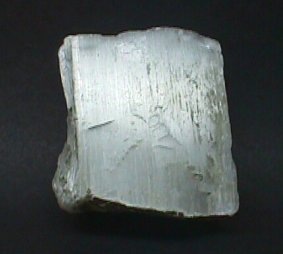The Mineral ulexite

Gigantic crystal formations of Ulexite occur in the form of fibrous, compact veins. When polished, these specimens become the well-known "Television Stone" or "TV Stone" sold to amateur collectors. The optical effect exhibited by Television Stone is caused by each of its individual crystal fibers acting as fiber-optic cables, transmitting light from one surface to the other. Since all the fibers are parallel and compacted together, any image at below is transmitted through each crystal fiber to the top surface. For this effect to be seen, specimens are polished with smooth surfaces.
Fibrous Ulexite bundles can also be carved into cabochons that display strong chatoyancy. However, due to its low hardness, it is unsuitable for gem use.
Chemical Formula
NaCaB5O9 · 8H2O
Color
White to light gray
Properties
Streak
White |
Hardness
2.5 |
Transparency
Transparent to translucent |
Specific Gravity
1.6 - 1.9 |
Luster
Silky |
Cleavage
1,1 - prismatic ; 2,1 - basal |
Fracture
Uneven to splintery |
Tenacity
Brittle |
Crystal Habits
Rarely in noticeable crystals; occurs in groups of tiny crystals in rounded or lenticular aggregates. It is most commonly seen as compact, parallel, fibrous veins. Occasionally encrusting and as radial compactions of thin crystals.
Varieties
-
Variety of Ulexite from Boron, California occurring in thin, parallel, sheetlike fibers. When polished at the top and bottom, each tiny fiber transmits light through the specimen, causing anything under the specimen to appear as if it is at the top.
Uses
Ulexite is an ore of boron, and is studied in regard to its unique optical properties. "Television Stone" is highly popular as a specimen among amateur mineral collectors.
Noteworthy Localities
The most outstanding deposit of this mineral is Boron in the Kramer District, Kern Co., California. Enormous veins of compact fibers are found in huge quantities at this location. Rounded, cotton-like masses occur in Death Valley, Inyo Co.; and in Dagget, San Bernardino Co., California. Other Ulexite deposits exist throughout the Mojave Desert in California and parts of Nevada. Ulexite also comes from Bigadic, Turkey and the Atacama Desert in Chile.
Distingushing Similar Minerals
The crystal habits and mode of occurrence distinguish Ulexite from practically all other minerals. Fibrous Ulexite may resemble asbestos minerals, but it only occurs in specific localities where asbestos minerals don't exist. Ulexite may also resemble Kernite, but Kernite's unique taste can immediately differentiate between the two.